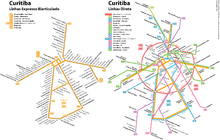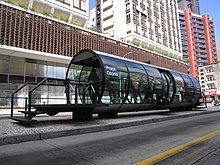Rede Integrada de Transporte


Rede Integrada de Transporte (Portuguese: Integrated Transport Net) is a bus rapid transit system in Curitiba, Brazil.
Curitiba has a well planned transportation system, which includes devotion of lanes on major streets for a bus rapid transit system. The buses are long, split into three sections (bi-articulated), and stop at designated elevated tubes, complete with handicapped access. The system, used by 85% of Curitiba's population, is the source of inspiration for the TransMilenio in Bogotá, Colombia, as well as the Orange Line of Los Angeles, California, and for a future trasportation system in Panama City, Panama.
History

By the 1960s, Curitiba's population had ballooned to 430,000, and some residents feared that the growth in population threatened to drastically change the character of the city. In 1964, Mayor Ivo Arzua solicited proposals for urban design. Architect Jaime Lerner, who later became mayor, led a team from the Universidade Federal do Paraná that suggested a reduction of traffic in the downtown area and a convenient and affordable public transit system.
This plan, known as the Curitiba Master Plan, was adopted in 1968. Lerner closed XV de Novenbro St. to vehicles, because it had very high pedestrian traffic. The plan had a new road design to minimise traffic: the Trinary Road System. This uses two one-way streets moving in opposite directions which surround a smaller, two-lane street where the express buses have their exclusive lane. Five of these roads form a star that converges to the city centre. Land farther from these roads is zoned for lower density developments, to reduce traffic away from the main roads. A number of areas subject to floods were condemned and became parks.
In the 1980s, the Rede Integrada de Transporte was created, allowing transit between any points in the city by paying just one fare.
Routes

- Express buses (Expresso Biarticulado): These are large high-capacity buses that have exclusive traffic lanes, spreading radially from the city centre in 5 directions. They are treated as an "above-ground subway" because of their speed, capacity and frequent service. They have bright red color schemes and operate with tube stations. Passengers pay to enter the stations. This allows very quick boarding and disembarking. It is considered shameful to cheat on fares.
- Inter-neighborhood buses (Interbairros): These are green buses that travel outside downtown. Lines 1 and 2 circle the city centre, the latter with a bigger radius. Lines 3 to 6 are important connections between some neighborhoods.
- Direct lines (Linha Direta): Commonly called ônibus ligeirinho (quickie bus), these are silver buses designed to be the quickest links between two points. They cover large distances with few stops. They link with tube stations. Curitiba is the pioneer in the worldwide Rapid Bus development.
- Feeding lines (Alimentador): These are local bus lines and are painted orange. All of them link one passenger terminal to a neighborhood and feed the express buses and other RIT lines with passengers. Large windows allow a better sightseeing.
- "Around Downtown" (Circular Centro): These small white buses are designed to circle the city centre, and are used by pedestrians as a quick way of getting to the other side of the area.
- Conventional buses (Convencional): These yellow-colored buses operate radially from the city centre.
- Interhospitals: These white buses circle the town and link the main city hospitals.
- Tourism line: These colorful buses focus on the city's attractions. Paying R$15.00 / US$6.25 allows one to get on and off of the bus four times, on the attraction of interest.
Terminals

Curitiba has twenty-one passenger terminals where it is possible to change buses without having to pay for a new ticket. They are located on Express lanes and offer travellers great flexibilty.
- Bairro Alto
- Barreirinha
- Boa Vista
- Boqueirão
- Cabral
- Cachoeira
- Campina do Siqueira
- Campo Comprido
- Capão da Imbuia
- Capão Raso
- Carmo
- Centenário
- CIC
- Fazendinha
- Hauer
- Pinheiriho
- Portão
- Santa Cândida
- Santa Felicidade
- Sítio Cercado
- Vilas Oficinas
